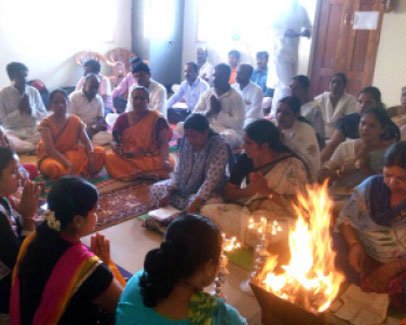 It is not necessary to explain about the harmful effects of atmospheric pollution in the modern age. The earth, forest, air and the water are getting polluted dangerously. This adverse situation was created by the growth of worldly affairs and physical desires. The man exploits the nature cruelly. This will result in the global warming and ultimately, even the existence of nature will be in danger.
It is not necessary to explain about the harmful effects of atmospheric pollution in the modern age. The earth, forest, air and the water are getting polluted dangerously. This adverse situation was created by the growth of worldly affairs and physical desires. The man exploits the nature cruelly. This will result in the global warming and ultimately, even the existence of nature will be in danger.
The ‘Yajnas’ (efforts) have been done everywhere in the nature to keep the balance of the universe and to maintain the life without any hindrances. The heat of the sun, the light of the moon, the movement of the air and the flow of the river are Yajnas. Similarly, human being also is a member of the creations of God. Agnihotra is the Karma that should be done by men to help the Gods of nonliving objects in their efforts. Its aim is to purify the heart of man also along with the purification of water and air in the nature. The ancient Indians considered it as an inevitable process to be observed in order to keep the environment clean. It was the duty of man to the nature. Agnihotra was one of the great five Yajnas to be observed in the mornings and evenings and was called ‘Devayajna’.
Charaka, the principle contributor to Ayurveda has explained in his text that there are three methods to maintain the health and the purity of the atmosphere. They are the Yajnas, smoking and growing medicinal plants. The ultimate aims of Yajna and Yaga are the purification of the atmosphere and spiritual development.
The purpose of Yajna and Yaga is to make our life happy and satisfied by enriching the nonliving Gods like the sun, moon, air and the fire. When the Gods are enriched, they will enrich us also. Bhagavad Gita also ascertains that it is possible to attain ultimate happiness by enriching each other in this way.
Agnihotra is to be performed during the sunset and sunrise. The materials used for ‘havana’ (firing) in Agnihotra are dry cow dung and pure cow ghee. The materials fired during the sunset will continue to purify the air till the next morning and provide comfort. The materials fired during the sunset will continue their purifying action till the evening and provide strength, wisdom and health to the people. Hence, we should meditate the God and perform Agnihotra in both evenings (the time of sunrise also is considered as an evening) when day and night meet.
The dry cow dung used in Agnihotra contains Menthol, Ammonia, Phenol and Formalin which destroy the bacteria while ‘homa’ is performed and protect the people from bacterial diseases. The cow dung has the capacity to prevent radiation also. It has been discovered that the smoke produced when cow dung is fired has the power to rectify the malfunctions of the lungs.
When the melted ghee (haviss) is poured into the fire, it will produce chemical named acetylene which will cover the polluted air and purify it. The odor produced when the ghee fall into the fire, will avoid the stress and strain of the mind. Our ancient saints believed that if Agnihotra was performed continuously, it would be an eternal solution for all sorts of problems caused by mental strain to the people.
Formaldehyde is an important product while the homa is performed. Formaldehyde has endless possibilities to purify the atmosphere. It removes the dusts from the houses and destroys the germs. Many chemicals such as Ascetic acid, Formic acid, Pyroligneous acid and Propionic acid are also produced from the fire of the homa. All of these are capable of keeping the houses free from the germs, protecting the plants and fruits from the insects and destroying the subtle creatures with higher immunity.
The eastern quarter where the sun rises is filled with very strong electrical forces in the morning. While performing Agnihotra at this time, it helps to attract the flow of vitamins from the solar system, which are required for the existence of life. Agnihotra attracts these forces and forms an aura around the men and plants near it and thus an atmosphere without diseases is created. The people attain peace and happiness. Hence, Sadhanapatham trains the followers to perform Agnihotra also.
